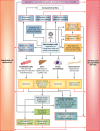Dengue virus pathogenesis: an integrated view
- PMID: 19822889
- PMCID: PMC2772360
- DOI: 10.1128/CMR.00035-09
Dengue virus pathogenesis: an integrated view
Abstract
Much remains to be learned about the pathogenesis of the different manifestations of dengue virus (DENV) infections in humans. They may range from subclinical infection to dengue fever, dengue hemorrhagic fever (DHF), and eventually dengue shock syndrome (DSS). As both cell tropism and tissue tropism of DENV are considered major determinants in the pathogenesis of dengue, there is a critical need for adequate tropism assays, animal models, and human autopsy data. More than 50 years of research on dengue has resulted in a host of literature, which strongly suggests that the pathogenesis of DHF and DSS involves viral virulence factors and detrimental host responses, collectively resulting in abnormal hemostasis and increased vascular permeability. Differential targeting of specific vascular beds is likely to trigger the localized vascular hyperpermeability underlying DSS. A personalized approach to the study of pathogenesis will elucidate the basis of individual risk for development of DHF and DSS as well as identify the genetic and environmental bases for differences in risk for development of severe disease.
Figures

References
-
- Acioli-Santos, B., L. Segat, R. Dhalia, C. A. Brito, U. M. Braga-Neto, E. T. Marques, and S. Crovella. 2008. MBL2 gene polymorphisms protect against development of thrombocytopenia associated with severe dengue phenotype. Hum. Immunol. 69:122-128. - PubMed
-
- An, J., D. S. Zhou, J. L. Zhang, H. Morida, J. L. Wang, and K. Yasui. 2004. Dengue-specific CD8+ T cells have both protective and pathogenic roles in dengue virus infection. Immunol. Lett. 95:167-174. - PubMed
-
- Andriopoulou, P., P. Navarro, A. Zanetti, M. G. Lampugnani, and E. Dejana. 1999. Histamine induces tyrosine phosphorylation of endothelial cell-to-cell adherens junctions. Arterioscler. Thromb. Vasc. Biol. 19:2286-2297. - PubMed
-
- Aoki, S., M. Osada, M. Kaneko, Y. Ozaki, and Y. Yatomi. 2007. Fluid shear stress enhances the sphingosine 1-phosphate responses in cell-cell interactions between platelets and endothelial cells. Biochem. Biophys. Res. Commun. 358:1054-1057. - PubMed
Publication types
MeSH terms
LinkOut - more resources
Full Text Sources
Other Literature Sources
Medical
Research Materials

